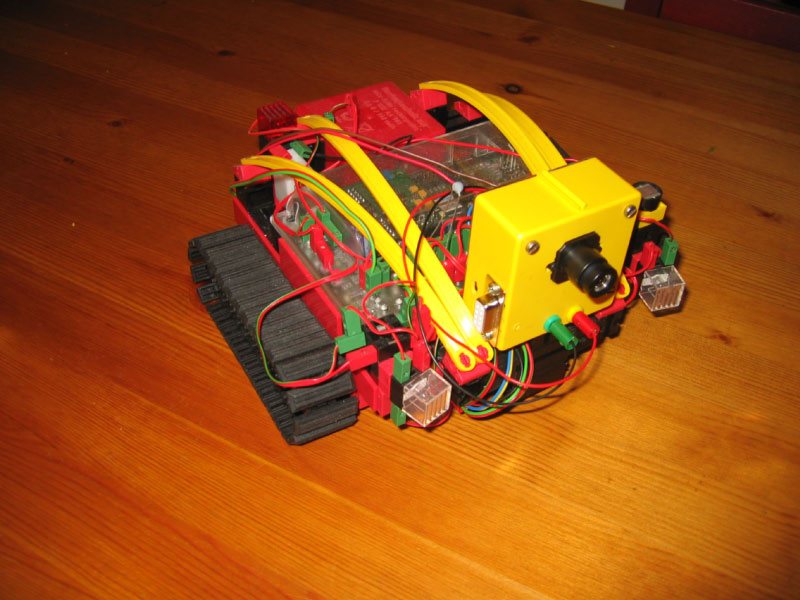cmucam_explorer_1

Hochgeladen am 16.1.2008, 16:52 von Ad. 6 / 7
The explorer with a CmuCam3
remadus (16.1.2008, 19:26:55)
Superb!
I would be pleased to hear some words from you about the data transfer from the camera to the following electronics. Please let us share your know-how.
Ad (16.1.2008, 19:38:47)
The CmuCam3 project is open source. The camera comes with CmuCam2 emulation software. This software accepts short ASCII commands and returns mostly ASCII data packets. I changed this software to accept RoboPro messages and also pack the replies as RoboPro messages. In this way it is quite easy to have the camera continuously issue messages with the x,y coordinates of a colourblob. So a robot can follow a coloured object or a gripper can be accurately positioned over an object to pick up.
schnaggels (17.1.2008, 11:14:27)
Great work, I was sure that this is possible but nobody tried it before :)
Is this picture just an example? The serial line connector on the left is not connected with the RoboIF?
Could you please share the ft adapted software for the Cam with us? Also think about buying such a cam for a long time…
Thanks, Thomas
Ad (17.1.2008, 13:33:18)
Yes, this just an example, I’m still testing and improving the software. You can track my progress on my homepage http://www.xs4all.nl/~weidena/
remadus (17.1.2008, 18:44:08)
There also exists a small brother of the cmucam. Try avrcam in internet. I saw this camera during a convention in Mörshausen. Was it shown by thkais? I am not sure.
Ad (18.1.2008, 13:35:02)
I didn’t know about the AVRCam so I looked it up. It is open source too and it is cheap. The kit costs $100, where I payed 180 Euro for the CmuCam3. The AVRCam has no FIFO however so it cannot store a full frame. I also think that the ARM processor is more powerful than the Mega8. The camera module is the same and the command structure looks similar. It should be possible to use the AVRCam as well.
niekerk (18.1.2008, 23:50:19)
In Mörshausen, I showed a Pob-Eye camera. It is remarkably similar to the CmuCam3: same camera sensor, same CPU, about the same price. But no framebuffer, no open source. And it does have flatcable connection to a 128x64 LCD. The physical dimensions are such that it just doesn’t fit in this yellow box of 60x60 mm, too bad :-(
thkais (20.1.2008, 20:16:03)
The avrcam is - although it uses only a one-line buffer- able to track up to 8 objects and is working well. Since the convention Mörshauen (2006 or 2005 I think) I didn’t use the cam, because I had no project where object tracking was useful. Amazing, what the author is doing with a small Mega8.
niekerk (21.1.2008, 20:59:05)
So, we have three different cams here: CmuCam3, AvrCam, and Pob-Eye. Each of them connected to the RoboInterface using the serial port. Now, which one can we recommend to others? It is not my intention to start a war here. And in fact I’m very sure that all of these camera’s have their good and bad points.
Maybe we need a contest :-) :-) How about picking the most colourful object, tracking it down, and touch it? OK, no war! Sorry! :-) :-)
thkais (21.1.2008, 21:24:37)
@niekerk: For “normal” purposes it doesn’t matter, which cam you will use. I choosed the avr-cam, because I am familiar with the avrs.I didn’t bought an assembled cam, but built the cam on a test-board (wire-wrapped). So it was a advantage, that the mega-8 ist avaible in DIP-housing. However, a arm-µC will have more performance for high-end applications, for example object-recognizing. The avr-cam is only able to track a colour, not a shape - at the moment ;)
schnaggels (13.2.2008, 16:17:37)
Found the CMUcam3 for only 150€ here: http://elmicro.com/de/cmucam3.html
schnaggels (13.2.2008, 16:37:15)
Sorry, with 19% MwSt also 178,50€. So you could also buy in my favorite shop here: http://www.roboter-teile.de/Shop/themes/kategorie/detail.php?artikelid=124&kategorieid=2&source=1
Defiant (13.2.2008, 19:18:12)
An ARM-µC will be still way too slow. You might want to consider using a FPGA instead if you are already familar with languages like VHDL.
With the right code the FPGA is able to calculate fourier transformation in no time. I started to work on something like that myself but havn’t followed the project in the last 3 months for various reasons.
However you might want to keep the rest like border detection on a µC since its much easier to program.
schnaggels (8.5.2014, 10:44:19)
Falls jemand noch interesse hat, die CmuCam 4 ist deutlich im Preis gefallen! ~106¤ http://www.roboter-teile.de/Oxid/Kamera-Module/CMUcam4-Fertigmodul.html?listtype=search&searchparam=cmu Jetzt übrigens auch als Shild auf dem Arduino nutzbar :)